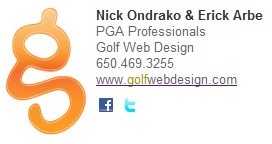Did your mother ever tell you – “you didn’t come with an instruction manual?”
We feel that same way about “e-Mail Etiquette”, there is no manual. We are all taught in school how to address a letter, but who writes a letter anymore? We need to take the tools we were taught about how to write a letter, and apply them to an e-Mail format.
We have been noticing more and more people’s lack of attention of “writing” when it comes to e-mails. We think addressing a few of these “e-Mail faux pas” will help to better present a professional e-Mail “letter” for your business.
Below are some ground rules when it comes to writing & responding to e-mails.
Get an e-Mail Signature
Here is our e-Mail signature at Golf Web Design. This is just an example of a more professional looking signature. I think it is important that a professional business person gives off a professional vibe. Have a uniformed and consistent e-Mail signature.

Use the person’s name
I can’t tell you how many times a day that we get e-mails that are not addressed to anyone is particular, they sender just starts typing content. Use the person / companies name when sending & replying to e-mails. It doesn’t matter if that is the 100th e-mail you sent to that person, address the e-mail just like you would a handwritten letter. You don’t have to put “Dear John”, just “John –“ or “Mr. Smith – “ is perfectly acceptable.
Proper Typography
Capitalize the first letter in a sentence. Do not use all caps. Do not use all lowercase letters. Use paragraphs. Use the bold and underline tool only when necessary. Just like a normal handwritten letter, just because the options of different colors and fonts are there doesn’t mean they should be used. Keep it simple.
Short and Sweet
People get a lot of e-mails. Keep it short and to the point, they will appreciate it.
Colors & Emotion Icons & Shortcode
Use color sparingly. Don’t use emotion icons like: 🙂 .Do not use LOL, OMG, TTYL.
Proper Subject Lines
Use appropriate subject lines – John Smith 10-20-2010 Lesson Video – not – lesson
Think of it this way; when John’s inbox is full or you send him another 20 lessons, he will appreciate you labeling the e-mail correctly so he could quickly find it later. Do this for all your e-mail subject lines.
Your customers will notice and appreciate (even if subconsciously) your professionalism. This always pays off in the long run, and really helps when building your brand.